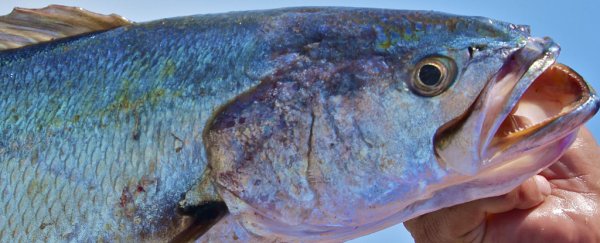Each year between February and June, the fish gather to spawn in Mexico's Colorado River Delta. The fish, a type of croaker called the Gulf corvina, meet in water as cloudy as chocolate milk. It's a reunion for the entire species, all members of which reproduce within a dozen-mile stretch of the delta.
When the time is right, a few days before the new or full moons, the male fish begin to sing.
To humans, the sound is machine guns going off just below the waterline. To female fish, the rapid burr-burr-burr is a Bing Crosby croon.
Make that Bing cranked up to 11.
Marine biologists who recorded the sound describe the animals as the "loudest fish ever documented," said Timothy J. Rowell, at the Scripps Institution of Oceanography in California.
Rowell and Brad E. Erisman, a University of Texas at Austin fisheries scientist, spent four days in 2014 snooping on the fish with sonar and underwater microphones.
The land surrounding the delta is desolate, Rowell said. Fresh water that once fed wild greenery has been diverted to faucets and hoses.
But the delta is alive with the sound of fish. "When you arrive at the channels of the delta, you can hear it in the air even while the engine is running on the boat," Rowell said.
Sound is measured differently in water than in air; still, the fish are as loud as lawn mowers, Rowell said.
The microphone recorded a chorus as loud as 202 decibels. Individual calls reached 177 decibels, the scientists report in a study published Tuesday in the journal Biology Letters. Whales are the only marine animals that are louder.
Gulf corvina, the authors reported, are four times louder than the next-loudest recorded fish.
In theory, their calls are powerful enough to damage the hearing of sea lions, the authors noted. But the hungry sea lions at the site don't seem to mind, possibly because they stick to eating fish from the periphery of the chorus, Rowell said.
"They are very loud fish," said Phillip S. Lobel, a biologist at Boston University who was not involved in this work. And the authors did a "very nice job" with this research. But to say these fish are the loudest species, however, requires what is "not an easy measurement to make," he said.
Gulf corvina have air sacs called swim bladders tucked within their bellies. "Sonic muscles," Rowell said, encircle the swim bladders. When the fish contract their abdomens, the muscles strike against the bladders like drumsticks on a snare.
The fish reach a crescendo during high tide. The chorus begins like the low rumble of a baseball stadium and ends like an angry beehive.
Rowell hypothesised that the fish are trying to outdo each other, akin to people shouting over each other in a crowded bar. When your neighbour plays the tummy drums as loud as possible, you have to be louder.
During that crescendo, Rowell and Erisman were able to collect eggs, suggesting that the fish spawn amid the cacophony.
Without visual confirmation, which is a difficult feat in the dark water, Lobel wasn't so sure these were spawning calls.
"They're not able to see what the fish are doing," he said. "And that's a big deal."
Hundreds of fish species make sounds. Fish are "kind of like birds," Rowell said. They make sounds while spawning, but also while they court other fish or while they fight.
And they can be annoyingly loud. A seaside Florida community almost wasted thousands in city council dollars trying to dampen what they thought was the noise of municipal utilities.
Until, as the New York Times reported in 2008, a graduate student in marine science pointed out the sounds were canal fish calling to mates.
The calls of the Gulf corvina are undoubtedly an important part of the animals' lives. "They also could be their downfall," Rowell said.
Fishermen follow the sounds of the Gulf corvina through the Colorado River Delta and work together to find where the animals congregate. There, they cast their nets.
"There's some concern," Rowell said, about the future of the fishery. Fish sizes have shrunk over the last five to 10 years, perhaps due to poachers, and the fish is listed as vulnerable by the International Union for Conservation of Nature.
Listening to the fish is a great way to monitor them, Lobel said. In decades past, fisheries scientists would catch fish and cut open their gonads. Or researchers collected fish larvae in a "plankton tow," he said.
Now, scientists can, in theory, record fish sounds and estimate population size without disturbing the animals.
It isn't easy. "What we need are the smart computer people to help us come up with computer algorithms to identify the sounds automatically," Lobel said. "It's a complicated acoustic problem."
A complicated problem, but not an impossible one. In July, Rowell, Erisman and their colleagues calculated, based on the fish sounds, that the clusters of spawning corvina represent as many as 1.55 million animals.
2017 © The Washington Post
This article was originally published by The Washington Post.
